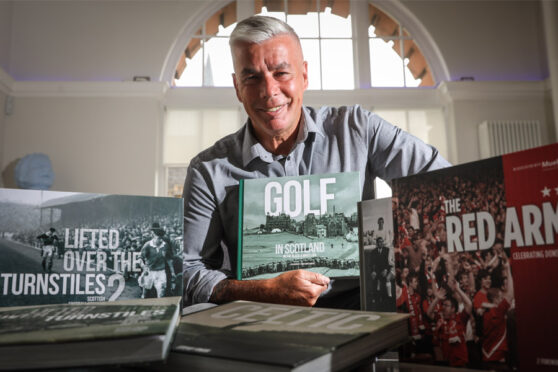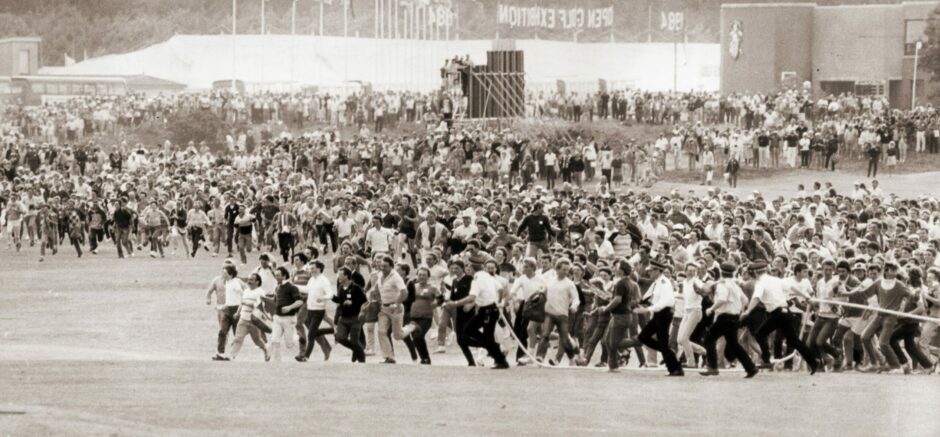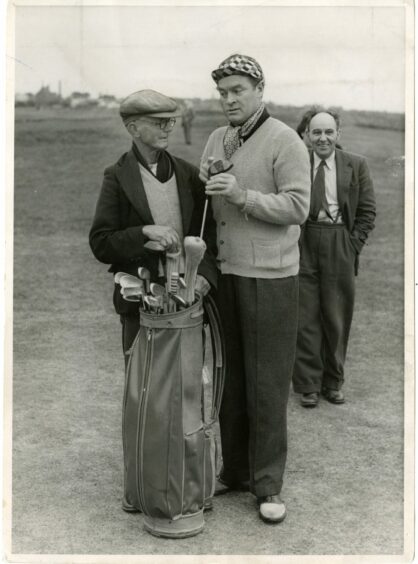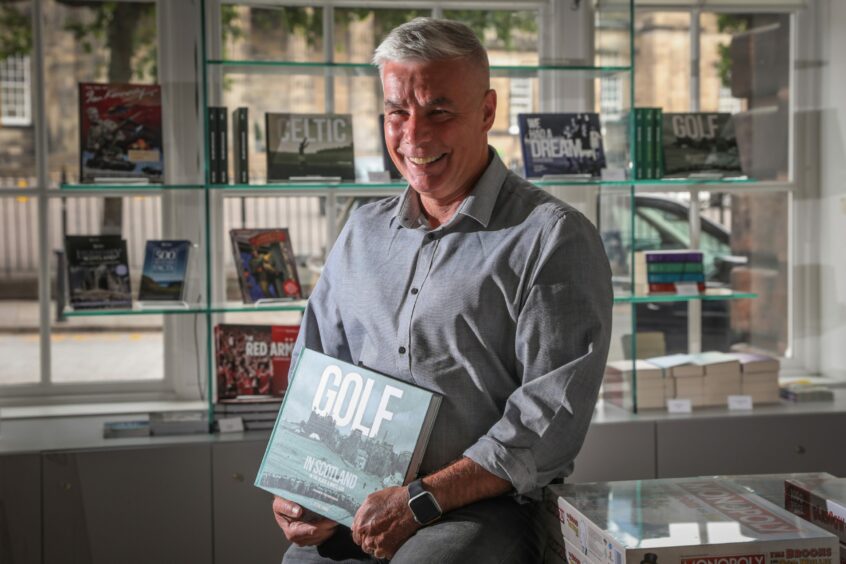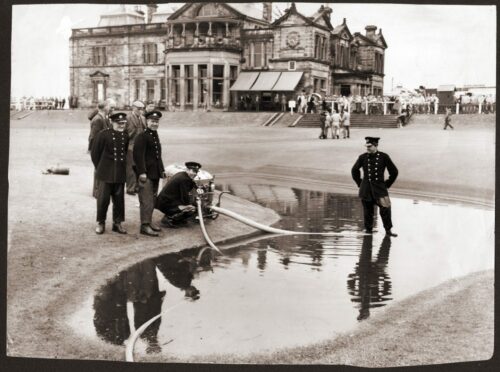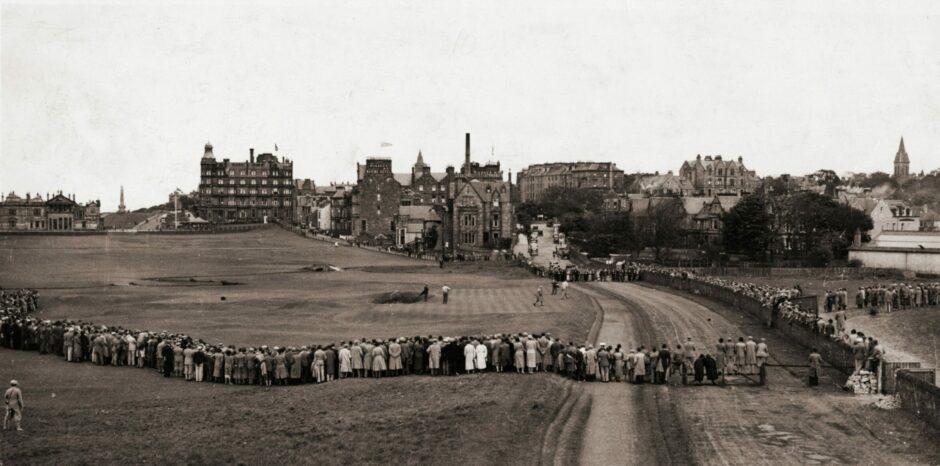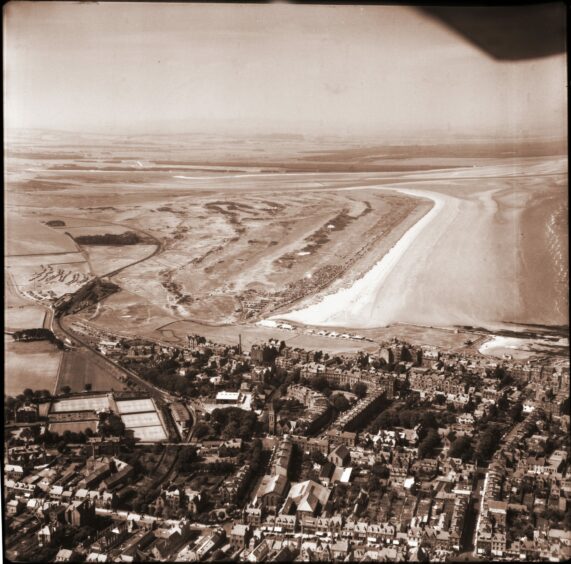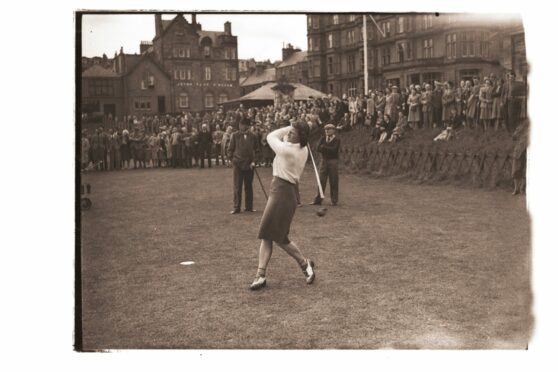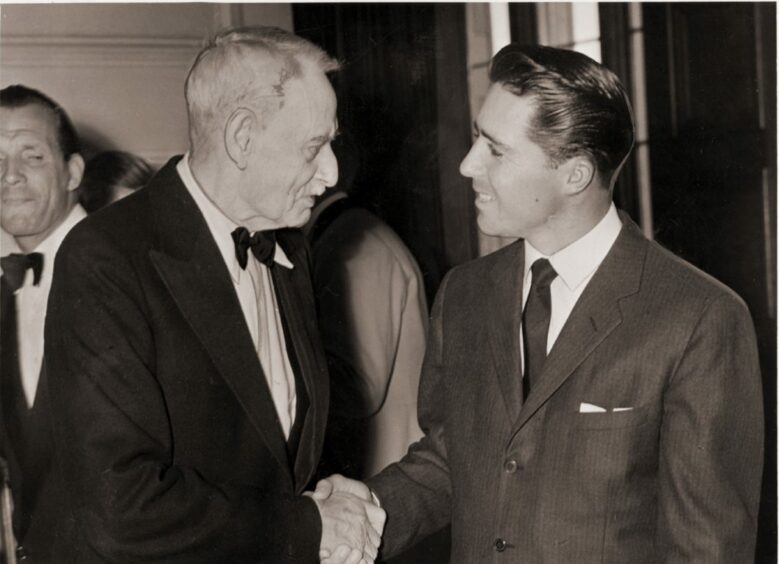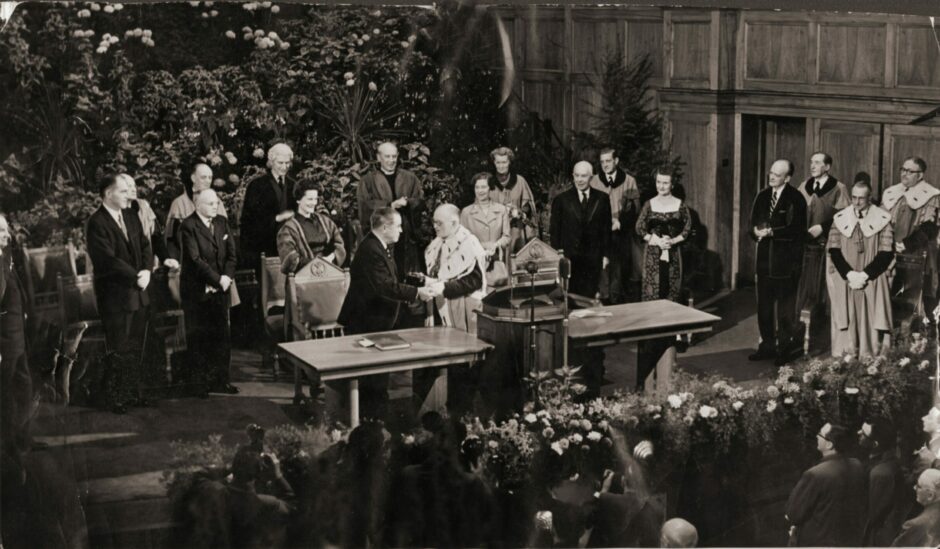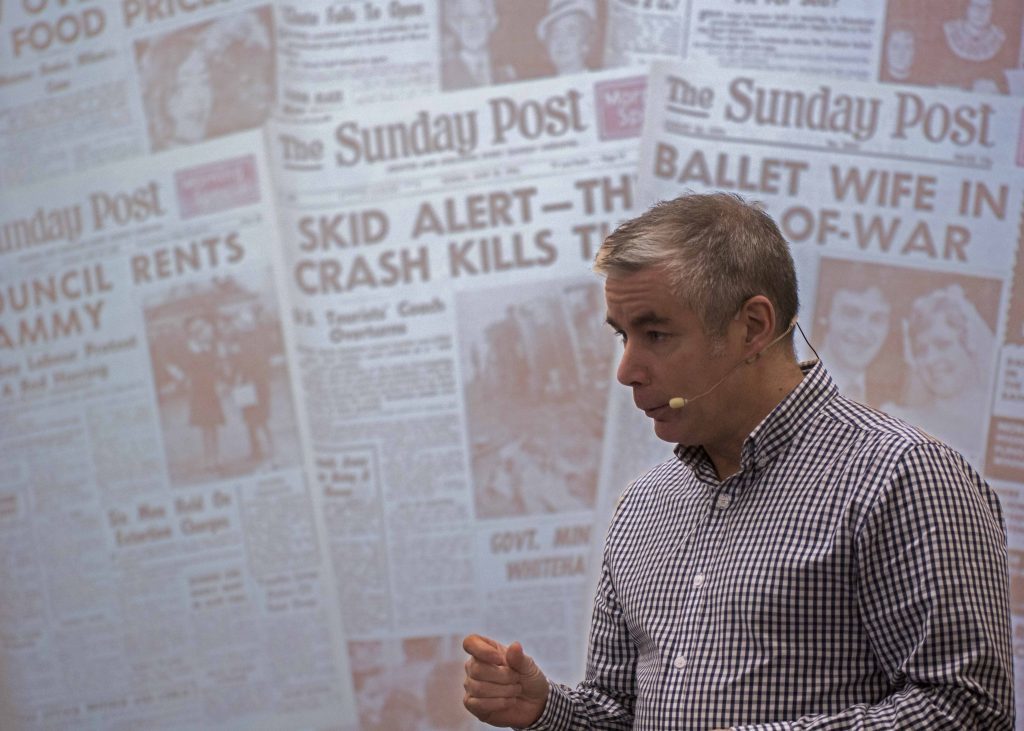Michael Alexander speaks to former Dundee journalist and author Steve Finan about his new Golf in Scotland book which features never before seen Open championship images from the DC Thomson & Co Ltd archives.
Specialists have written many books over the years about golf’s greats and tournaments of the past.
But what former Dundee journalist and author Steve Finan has tried to present in his new book ‘Golf in Scotland in the black and white era’ is something of a first – a golf book from the perspective of spectators.
Power of nostalgia
From sedate crowds gathered round the 18th green of the Old Course to watch Peter Thomson win the 1955 Open, to crowds charging down the fairway ahead of Seve Ballesteros’ famous St Andrews victory in 1984, the never before seen photographs have been languishing in the DC Thomson & Co Ltd archives for decades.
Stunning aerial shots chart subtle changes to the layout of the town and Old Course.
They hark back to the days when trains ran alongside the fairway and give an insight into the construction of the Old Course Hotel.
But most significantly, whether the reader is an international golf fan visiting the Home of Golf or a more local reader recalling fashions and occasions of days gone by, the treasure trove presents a feast of multi-layered nostalgia.
“I go out to do talks to memories groups and men’s mental health groups,” explains Steve, 59.
“Whenever you talk to these guys or show them photos, they like pictures of old golfers or old footballers depending on what I am doing.
“But they like best the wide angle shots that show tournaments – St Andrews – as they remember it.
“Sometimes they are in the pictures and think ‘I must be in that crowd’ – that sort of stuff.
“But no one has ever attempted to do a book that shows the game as it was on the ground – the tournament itself. The experience from the spectators’ point of view.
“This book is unique in that it’s very difficult to get a book full of new ‘old’ photos which we have in the archive.
“To show the peoples’ game as it were is a very different concept to any golf book that’s ever been done before, and I’ve become quite proud of this.”
Delving into the archives
Originally from Monifieth and now based in Carnoustie, former DC Thomson & Co Ltd journalist Steve has produced 12 sporting nostalgia books and further nostalgia books that are non-sport.
They all feature previously unseen photographs from the depths of Courier publisher DC Thomson & Co Ltd’s archives.
In the old days of black and white photography, long before digital, professional newspaper photographers might shoot four or five rolls of 35mm film at a sporting event.
In the older days of gelatin dry plate negatives, a mere handful might have been taken.
Only a small selection would have been processed for publication, and many of those would have been published again and again in newspapers, magazines, books and more recently websites.
But the others have lain unlooked at in the archives for 40, 50, 60 years or more – until now.
The negatives were merely waiting for someone like Steve to come along to painstakingly examine them all with a light box and magnifying glass. This book is the result!
Golf through the ages
Chapters spotlight The Old Course, pre-1950s, the 1950s, heroes of the women’s game, St Andrews itself and Carnoustie.
There’s a spotlight on the 1960s, the 1970s and St Andrews from above. There’s even a whole chapter on golf and the weather.
With the final days’ play of the 150th Open championship upon us, however, perhaps one of the most topical sections is ‘The Changing Face of the Game’ which spotlights changes in the culture surrounding golf.
“It goes back to the days when there was almost no policing on golf courses,” says Steve, whose own earliest Open memory was sneaking in to Carnoustie in 1975 as a 12-year-old.
“People were just expected to be polite and to behave themselves and to be quiet when shots were taking place.
“Nowadays you need people with signs up and ropes and chains and things to force people to do that.
“Back then it was done because people felt that was the decent thing to do.
“I find pictures like that really quite astounding.”
In the days when golf was still a “cardigans and pipe” sport, a picture of Sam Snead on his way to winning The Open at St Andrews in 1946 show the largely self-policing crowds standing respectfully around the 17th Road Hole.
By contrast, this image is juxtaposed with a picture from the 1984 Open as police race to create a cordon to hold the crowd amid a stampede.
It was as if “football culture” had permeated golf.
“I’ve a great respect for those old days that show the game when it really was a gentleman’s sport and when it was a bit simpler, a bit less rushed,” says Steve.
“Obviously it had to change because it was such big business.
“But photographs over the decades chart the way the game has gone.
“Every time it comes back to St Andrews, speaking to locals, it’s bigger, some would say better.
“It’s noisier, it’s more glitzy, more glamour.
“There’s more tourists, there’s clearly more money in the game.
“But it wasn’t always like that. I like to remind people of the way it was back then when it was kind of more Scotland’s game.
“Again I feel I can illustrate that with this book.”
St Andrews from above
Another chapter that’s generated a lot of interest amongst golf aficionados is the aerial shots, including a lot from the 1950s.
People like to look at the differences – where the tees are, or how the course played when the railway or the railway sheds were in play.
How do different bunkers come into play now that people are generally now longer off the tee?
“I find that fascinating,” says Steve, “and some of the best conversations I’ve had with people who really know their golf is the different way that golf plays with the big hitters now.
“You can see where the first tee shots would land, but it’ a different thing altogether now because they land in a different place.”
It’s also fascinating to look at how the town of St Andrews itself has changed over the years.
“When I’ve showed this book to Americans, they are amazed how ancient but how small St Andrews is,” adds Steve.
“There’s one photo of the peninsula that all the courses are on, and from the air it looks so fragile. Like a good wave from the North Sea could wash over it.”
Heroes of women’s game
In the chapter on women golfers, Steve has dedicated a section to the legend that was Babe Zaharias.
Described as a “phenomenon” and “possibly the greatest female athlete that ever lived”, ‘The Babe’ visited Scotland in 1947 and was a media sensation.
“She’d do things like stick a match in the ground behind her ball so when the ball was struck there was a puff of smoke and a loud crack,” laughs Steve.
“She’s a phenomenon in herself. I don’t think we’ll ever see her likes again. Just stunning.”
Historic rarities
Other rarities include a fantastic photograph of Gary Player shaking hands with St Andrews native Willie Auchterlonie who, at that point in 1960, was the oldest surviving Open champion winner dating back to 1893.
With Jack Nicklaus being awarded honorary citizenship of St Andrews during The Open week in 2022 – as exclusively revealed by The Courier in January – he’s also gone back to look at when Bobby Jones got freedom of the city of St Andrews in 1958.
There’s an historic image of St Andrews greenkeepers who deserve their place amid the history of the game.
There’s also a chapter that shows St Andrews as a golf town – putting the golf courses into context.
“There’s things you realise when you see St Andrews – it’s so different to American courses,” he adds.
“Golf starts and finishes inside the town itself. There’s that natural amphitheatre of buildings around it.
“Out in America, they are amazed when they see this because golf is a country club thing which is done away out in a state nowhere near towns.
“In St Andrews, you walk up and down the streets and it’s just the normal turn of events.
“People just accept that for what it is.”
Fascinated by history
When Steve worked at the Sunday Post, he spent a great deal of time in the DC Thomson archives and found it a “strangely addictive process”.
Years ago, an old editor said to him: “If you are going to be a newspaper man, you’ve got to know your newspaper back to front. You don’t just know your paper today, you know its history.”
He hopes his excitement of coming across previously unseen photographs is something that comes across in the book.
Where to get the book
Golf in Scotland in the black and white era, by Steve Finan, is available in all good bookshops, RRP £24.99.
It can also be ordered direct from the DC Thomson shop here.
*Steve Finan will be signing copies of his book at Waterstones, St Andrews, at 1pm on Saturday July 16.
